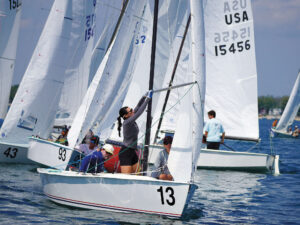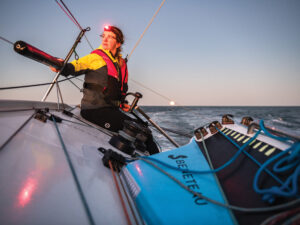
Reshaping Oly III
In Part I and Part II of this three-part series I outlined the uncertain future of Olympic sailing and some changes that ISAF should make for the 2008 Olympic Regatta in Qingdao. This is likely to be a very trying fortnight for sailing. The prevailing light conditions, the extreme isolation from the rest of the Olympic events, and an antiquated format will all work against the sport in 2008. We’ll be lucky if sailing can hold its ground in terms of how the sport is viewed by the International Olympic Committee, the Olympic broadcasters, specifically NBC, and the non-sailing public. If we’re unlucky, sailing could really take it on the chin.
Regardless, sailing needs to approach the 2012 Olympics as if its Olympic future is on the line. It needs to deliver a standout performance. Fortunately, the English people (and the nearby Western Europeans) appreciate sailing and should come out in droves to see the action. Weymouth looks like a great choice for the regatta site. While removed from London, it’s a manageable day trip. It should be possible to put multiple courses within sight of land and make it easy for spectators to take in the action.
However, sailing cannot depend on the venue or its popularity in Europe to lift it back into the good graces of the IOC. The Olympic format needs a drastic overhaul.Before I get into that, though, a short treatise on the Olympic motto, Citius, Altius, Fortius, which translates to Swifter, Higher, Stronger. Unstated, but equally as important, is a proviso that could read, “ when it counts.” The Olympic archives are loaded with supremely talented athletes who, for whatever reason-luck, nerves, adverse conditions, bad seafood, etc.-came up short on the medal day, and with stories of slightly less-talented athletes who, for that same day, were the best in the world. This is what makes the Olympics so engrossing and it’s part of what makes sailing one of the least-watched Olympic sports. The current Olympic regatta format, with 11 races and one throwout, allows for too many second chances, and is too effective when it comes to removing luck from the equation. Consider the Finn regatta in Athens. Ben Ainslie, the reigning world champion and a heavy favorite, opened with a ninth and a DSQ. In most other Olympic competitions a start like that would’ve sent him packing. But Ainslie merely dominated the next four races (three firsts and a fourth) and was in first place with the regatta barely half over. He won the gold by 13 points. It wasn’t even a dramatic comeback.
Across the medal board in the Athens Olympic Regatta there were few, if any, surprises. Some will say that’s proof that the right people won. But the Olympics are about finding the man or woman of the moment. Upsets, complete with triumphant underdogs and heart-broken favorites, make the competitors seem human and the competition up for grabs, they make people tune in. In an op-ed piece speaking against the recent change in Olympic scoring, one respected sailor and Olympian noted that sailing isn’t speed skating. Too true, but even a sport like that, where so many factors are controlled, involves plenty of luck. Check out this brief history of Dan Jansen. If he was a sailor, given how our sport accommodates for misfortune, he could’ve won three gold medals. Yet winning only one made him a household name across the United States.
ISAF should condense the Olympic format and focus the pressure. The new scoring protocol, with the 11th race counting for double points, involves none of the vision necessary to re-energize the Olympic regatta. The regatta should have two parts, a 6-race preliminary, with one throwout, after which the top 10 to 15 boats move into a five-race final. The qualifiers would carry the positional placements of the preliminary portion into the finals as one race.There will be no throwouts in the finals, which will reduce the chance of any sailor clinching before the final race, and I like ISAF’s idea of using on-the-water judging for the final race to eliminate any protest hearings. A high-point scoring system for the finals will make it easier for the public to follow.
With the format now decided, it’s time to pick the classes.
The IOC reportedly plans on contracting sailing, so I’m going to assume we’ll have 10 classes, rather than 11. The worst thing ISAF can do is approach this like it has in the past, creating a Survivor-style elimination in which the class with the least political savvy is voted off Olympic island. Instead ISAF should start from scratch, forcing each class to earn its Olympic status. Five easily make the grade: the men’s and women’s windsurfer divisions, the Laser and Laser Radial, and the 49er. Though I haven’t seen it in action, I’m willing to give the new RS:X sailboard the benefit of the doubt, especially since fan-friendly slalom racing is now part of the program. The Laser is one of the most popular racing dinghies, the ultimate one-design, and there must be an inexpensive ubiquitous boat in the Olympics. It encourages participation from developing nations and combats the infuriating notion that sailing is only for the rich and privileged. The 49er is the most exciting boat in the Olympics. It requires an exquisite combination of athleticism and sailing skill and the shorter courses create a lot of close crossing situations. Nothing personifies Citius, Altius, Fortius like Julian Bethwaite’s skiff.
The next five are significantly more difficult. The only viable professional sailing tour is based around match racing and ISAF needs to build on this-a strong link between the Olympics and the America’s Cup makes great sense. Match racing is great for spectators and it’s easy to follow. Best of all, the winner of the last race is the champion. The boat should be a three-man keelboat with some zip. One good example is the 23-foot, 1,300-pound Streamline, which is used in the St. Mortiz Match Race in Switzerland. It has twin trapezes and a symmetric spinnaker. The boat must reward athleticism and it’s got to be fast.
The women will need a keelboat, but for fleet racing. Again the boat should be fast and challenging to sail, a small three-person sportboat that planes downwind; something akin to the Viper 640, the Laser SB3, the RS Elite, or the RS K6. To pick these two three-person boats, ISAF should to host evaluation trials and encourage, possibly through grants, the creation of some new designs. These have worked well in the past-that’s how the 49er and the RS:X earned their Olympic stripes, and the Tornado was forced to modernize.Speaking of catamarans, we’ll need one of those. The new Tornado held its own at the ISAF catamaran trials a few years back. Of course, having a 10-foot beam gives it a huge advantage over the rest of the field, which max out at approximately 8 feet wide. At some point ISAF might want to move to a more trailer-friendly boat. But for the moment, it’s the fastest boat on the water and that alone makes it a good choice.
Designed in 1963, the 470 is getting long in the tooth. However, in Athens I was really impressed at how modern 470 sailors have milked enough power out of the small sailplan to put the crew on the wire in 8 to 10 knots. They’ve clearly pushed the development of this design to the edge. But it’s still too underpowered for two men, so make it a coed class, one woman and one man on each team. This is a novel twist that will draw media interest. Sailors often talk about how it’s a great equalizing sport, how men and women can compete against each other. Let’s prove it. For the final class I’m torn between a high-performance singlehanded skiff (such as the Musto Skiff, with racks and a spinnaker) and a high-performance doublehanded keelboat. I’m leaning toward the latter because it will accommodate a broader weight range. I don’t have a particular design in mind, but it needs a spinnaker and a trapeze and must to be powerful enough to accommodate bigger sailors. Again a set of design trials will prove valuable.
This plan will certainly draw fire from the traditionalists, especially those in the Finn, Star, and Yngling camps. But ISAF must modernize the Olympic classes; clinging to aging designs is only hurting the sport. With all due respect to the many great sailors who’ve emerged from the Star class-and to the strength and knowledge required to win in this class-watching a Star boat go around the windward mark is like watching an elderly man extract himself from a plush recliner. The main goes out, the tip of the rig leans precipitously over the bow, the jib flaps like a broken wing until stretched out with the whisker pole, and then the crew crawls onto the bow. It’s agonizing. The Yngling was designed as a youth trainer. It’s insulting that we force the top women sailors in the world to sail a boat intended to train teenagers how to fly a spinnaker. The Finn should’ve been pink-slipped when the Laser came in.Sailing needs the Olympics. Unfortunately, the reverse isn’t true. Sticking with current format is daring the IOC to take drastic action. The reforms I’ve suggested are extensive. But they won’t compromise the soul of the sport; boat speed, boathandling, and tactics will still decide who wins and who loses. Modern Olympic sailors are professional athletes; those who find their classes dropped should easily transition to another class that suits them. In the end a revamped Olympic regatta will be more attractive to the general public, the media, and the IOC, and sailors around the world will benefit.
Stu’s Olympic Proposal for 2012Format
For the fleet-racing divisions, the regatta will have two parts, a six-race preliminary and a five-race final (with more races for the 49ers and possibly the windsurfers). A throwout will be allowed in the preliminary round. Approximately one-half to one-third of the fleet (but no fewer than 10) will qualify for the finals, the positional placements will be carried over as a single race. There will be no throwouts in the finals and on-the-water judging will be used for the last race in each discipline. For the match racing, 16 teams will be divided into two pools of eight. After a single round robin, the top two teams in each pool will advance to a best-of-five semifinal. The gold medal will be decided by a best-of-five final.
Classes
1. Men’s Windsurfer RS:X
2. Women’s Windsurfer RS:X
3. Men’s Singlehanded Dinghy Laser
4. Women’s Singlehanded Dinghy Radial
5. Open Doublehanded Dinghy 49er
6. Coed Doublehanded Dinghy 470, or similarly sized dinghy or skiff.
7. Men’s Doublehanded Keelboat High-performance boat with spinnaker and a possible trapeze
8. Open Match Racing Three-person keelboat with double trapeze
9. Women’s Keelboat dinghy Three-person planing keelboat w/possible trapeze,
10. Open Catamaran Tornado









